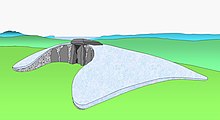St Lythans
St Lythans (Welsh: Siambr Gladdu Llwyneliddon, locally also known as Maesyfelin, Maes-Y-Felin, Saint Lythan's or Gwal-y-filiast - German kennel of the greyhound bitch) is the megalithic part of a Cotswold-Severn chamber in a Long Barrow , which was built in the middle of the Neolithic (around 4000 BC) in the hamlet of St Nicolas in the Glamorgan Valley in south Wales and is incorrectly called a dolmen .
St Lythans was originally covered by a cairn similar to that found at Tinkinswood's Cotswold Severn tomb (remains are preserved under the sward). The hill was about 24 m long and 11 m wide. The chamber, which was at the eastern end, consists only of three bearing stones and a capstone weighing about 35 tons. The dolmen was examined by the antiquarian WC Lukis before 1875 and excavated in 2011.
Evidence of a dry stone facade was discovered in the area of the forecourt. The Long Barrow was made from local limestone . The small finds consisted of Neolithic ceramics, flint and bones.
literature
- Vicki Cummings, Alasdair Whittle: Places of special virtue. Megaliths in the Neolithic landscapes of Wales. Oxbow, Oxford 2004, ISBN 1-84217-108-9 , p. 180.
- Homer Sykes: Mysterious Britain - Fact and Folklore George Weidenfeld & Nicolson Ltd. 1993 ISBN 0-297-83196-8 p. 113
Web links
Coordinates: 51 ° 26 ′ 33.1 ″ N , 3 ° 17 ′ 41.7 ″ W.

